Using computer simulations, researchers have pieced together a possible scenario where Titan caused another of Saturn’s moons to break up and become the beautiful ring system we see today. Plus, organic molecules on Mars, the death of the dinosaurs, and a review of Lightyear on Disney+.
Podcast
Show Notes
Death from the skies: dinosaur edition
- Not one, but two asteroids might have slain the dinosaurs (Science News)
- “The Nadir Crater offshore West Africa: A candidate Cretaceous-Paleogene impact structure,” Uisdean Nicholson, Veronica J. Bray, Sean P.S. Gulick, and Benedict Aduomahor, 2022 August 17, Science Advances
Non-dino extinctions tied in time to volcanic eruptions
- Dartmouth College press release
- “Continental flood basalts drive Phanerozoic extinctions,” Theodore Green, Paul R. Renne, and C. Brenhin Keller, 2022 September 12, PNAS
Perseverance finds an abundance of organics
- NASA press release
Saturn’s rings are made of a broken-up moon
- UC Berkeley press release
- “Loss of a satellite could explain Saturn’s obliquity and young rings,” Jack Wisdom et al., 2022 September 15, Science
- “Measurement and implications of Saturn’s gravity field and ring mass,” L. Iess et al., 2019 January 17, Science
Thirtieth Rocket Lab Electron launches
- Rocket Lab press release
Transcript
Our universe is a wild place, and our solar system hasn’t escaped from taking the occasional rock to the face. From the extinction of dinosaurs to the creation of Saturn’s rings, bad days involving big rocks have shaped life and shaped worlds — even to the point of bringing worlds like ours and Mars the water necessary to allow life as we know it to potentially exist,
In today’s episode, we dive into our world’s history of mass extinctions while looking outward to Saturn and Mars. We look at not just dino death but also at the discovery of the building blocks of life on Mars.
And we have a review of Disney’s movie Lightyear.
All this and more, today, here on the Daily Space.
I am your host, Dr. Pamela Gay.
And we are here to put science in your brains.

I am a fan of dinosaurs. I am also deeply appreciative of the fact that their extinction made it possible for evolution to get to the point that I can be here to tell you about how I like dinosaurs.
Geologically, our world has a layer of dying-off dinosaurs capped by a layer of iridium that indicates that something from space self-destructed on the surface of Earth and threw all the iridium into our atmosphere where it settled like a marker saying “Here be Asteroid Debris”.
As the story goes, in the 1970s, petroleum engineers on the lookout for oil found a super weird geological anomaly on the Yucatan peninsula that ended up associated with a crater impact in the 1990s. The size, age, and other features are all consistent with this crater being the crater formed by a dino-killing space rock.
But what if it didn’t work alone?
A newly discovered 8.5-kilometer potential crater has been found under the sea floor off the coast of West Africa. This work is described in a new paper in Science Advances that is led by Uisdean Nicholson. The crater appears to be the right age, and if this situation is correctly understood, it could be that two fragments from the same object hit us, or that this was just a freak accident with two rocks getting us in their sights at the same time.
More research and potentially difficult digs under the ocean are going to be needed to fully understand this discovery. Whatever happened, I love that there are still big things to discover hidden on our world.
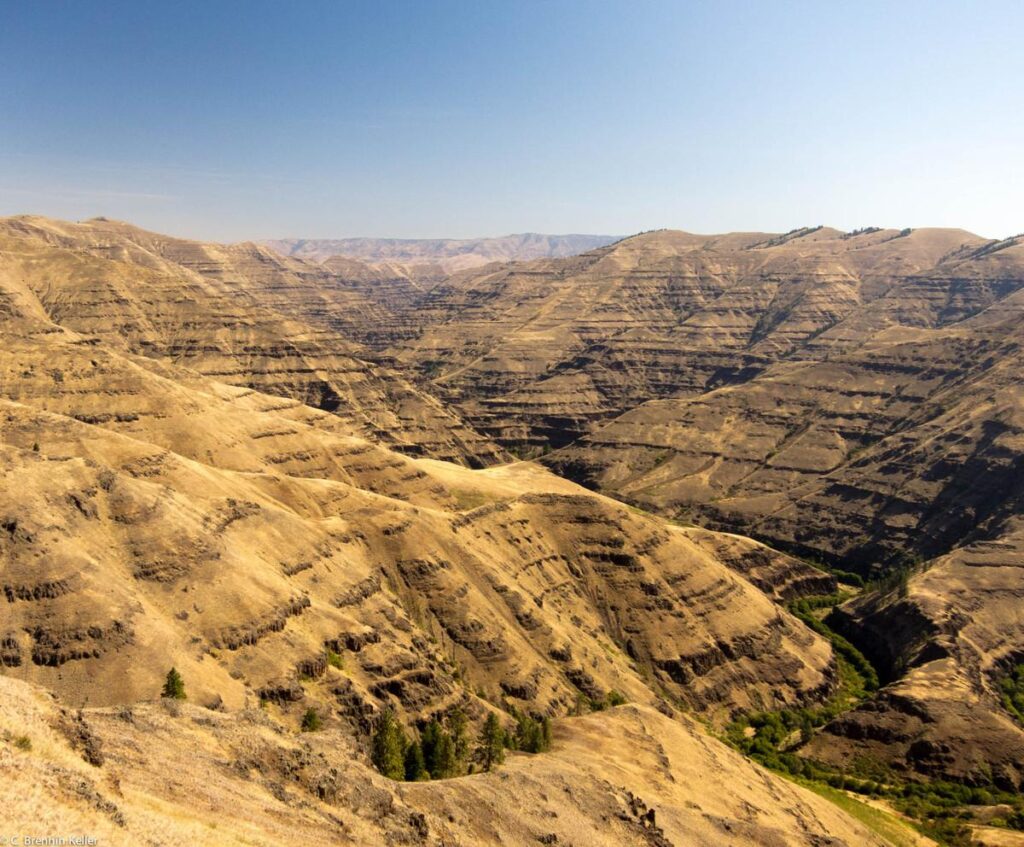
The dinosaurs weren’t the only die-off in Earth’s past. And, hey, we are living in the middle of an ongoing massive extinction right now. Life – with a few exceptions like alligators, coelacanths, and a few other critters – is fragile. Our world has had five other massive extinctions, and trying to figure them out is an ongoing challenge.
Researchers hunt through the geologic record for any and all details on just what might be to blame, and in a new paper in the Proceedings of the National Academy of Sciences, research by Theodore Green, Paul R. Renne, and C. Brenhin Keller associates these five extinctions with massive volcanic events. It’s possible that external factors triggered these events, but this is a start.
And a reminder to just keep monitoring volcanoes – not that we can stop them – but so we at least have some warning.
While I do dinos with the best of the not-a-paleontologist science communicators, planetary ring dynamics and organic chem are not my things. We’re now going to turn things over to Beth Johnson to talk about the organics on Mars you need to know.
In our last show, we talked about some of the latest science results from NASA’s Curiosity rover, which included a bit of a look back at the past ten years on Mars. Then yesterday, NASA held a press conference to update the public on the Perseverance rover.
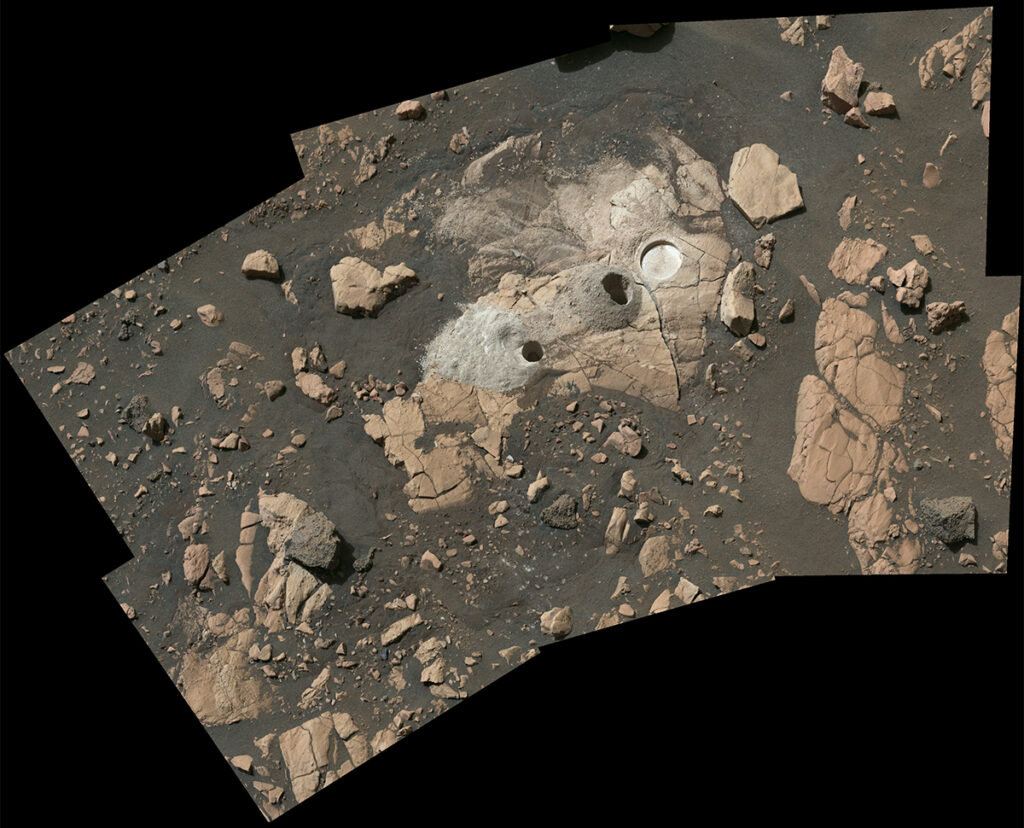
Perseverance landed in Jezero Crater on Mars back in 2020, which may feel both like not that long ago and also ages ago at this point. Jezero crater was once a lake back when Mars still had water, and within the crater is a river delta that formed from a river draining into that lake about 3.5 billion years ago. Project scientist Ken Farley explains the choice of landing zone: The delta, with its diverse sedimentary rocks, contrasts beautifully with the igneous rocks – formed from crystallization of magma – discovered on the crater floor. This juxtaposition provides us with a rich understanding of the geologic history after the crater formed and a diverse sample suite. For example, we found a sandstone that carries grains and rock fragments created far from Jezero Crater – and a mudstone that includes intriguing organic compounds.
And as a part of the rover’s mission, Percy is taking samples of rocks for both onboard analysis and later pickup by the planned Mars Sample Return mission. So far, a dozen samples have been taken to date. While collecting samples from a region nicknamed “Wildcat Ridge”, the rover abraded some of the rock that was then analyzed by the SHERLOC instrument. Using Raman spectrometry analysis, SHERLOC found an abundance of organic molecules. Farley notes: The fact the organic matter was found in such a sedimentary rock – known for preserving fossils of ancient life here on Earth – is important.
Organic molecules do not necessarily indicate past life; they are simply molecules that contain carbon. Understanding just what these molecules are and what they indicate about the sand, mud, and salt of the rocks on the ridge will have to wait for the sample return.
From organic molecules on Mars, we now turn to Saturn and the formation of its rings.
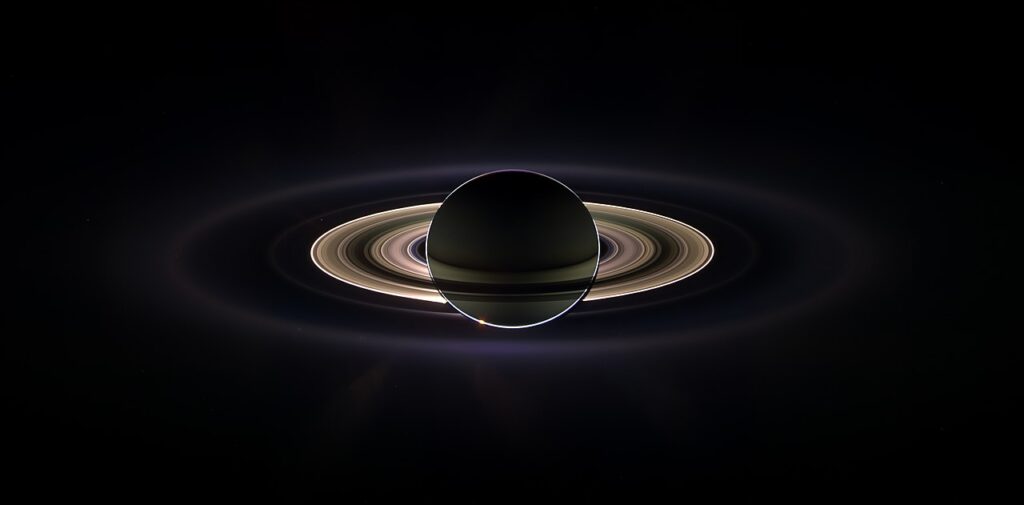
Ask almost any astronomer, professional or amateur, what got them interested in space and almost every one of them will have a story about the first time they looked through a telescope and saw Saturn. I still remember my first time, using a cheap, department store telescope my foster brother gave me. My father set it up in the backyard and pointed it at Saturn, and there were those rings. I was in awe, and it stuck with me. There is something about seeing Saturn’s rings with your own eyes through a tiny lens that brings out the astronomer in everyone. No matter the age of the audience, pointing a scope at Saturn is a surefire way to bring out the oohs and aahs at any star party.
Those rings are gorgeous. And while Saturn isn’t unique for having rings – Jupiter, Uranus, and Neptune all have ring systems – those rings are unique in that they can be seen with a basic telescope from Earth. To see the rings of the other giant planets, you need massive telescopes or spacecraft. Uranus’s rings were discovered in 1977, and since then, Voyager 2 and Hubble observations have led to the identification of thirteen distinct rings. Jupiter’s rings were first seen with Voyager back in 1979 and most recently imaged in the infrared with JWST. And while there were hints that Neptune had rings, they weren’t conclusively found until Voyager 2 swung by the ice giant back in 1989.
Obviously, ring systems are easy to acquire for giant planets, but the question still remains of how Saturn’s system is so much bigger and brighter than the other three systems. Saturn’s rings extend out from the planet’s equator starting 7,000 kilometers from the cloud layers and going all the way out to 80,000 kilometers. They are almost entirely made of water ice, which is another huge difference between the giant planets – Jupiter and Neptune’s rings are mostly dust.
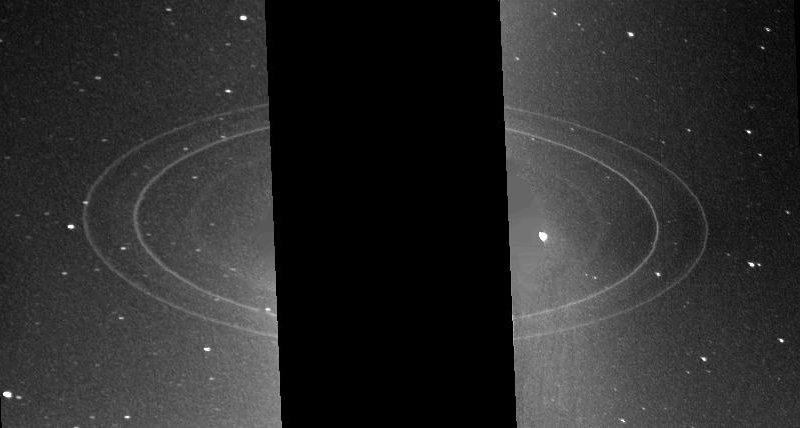
In the past decade or so, many scientists have studied the extensive data collected by the Cassini mission to understand just how and when Saturn’s rings came to be. Back in 2019, the age of the rings was determined to only be about 100 million years, which is very young by our solar system’s standards. And now in a new paper published in Science and led by Jack Wisdom, scientists have figured out what might have happened to create the rings – a large moon of Saturn was likely torn apart by tidal forces, leaving behind all that water ice.
The scientists have named this possible moon Chrysalis, as in what a caterpillar becomes before it transforms into a butterfly. (Sometimes, astronomers are good at naming things.) Using computer simulations, the team found that this potential former moon was close in size to Saturn’s third largest moon, Iapetus.
As to how the moon ended up being torn apart, that involves – oddly enough – Neptune and – not so oddly – Saturn’s other moon, Titan, which is second only to Jupiter’s Ganymede in size when it comes to moons in our solar system.
Way back before the ring system came into existence, Neptune and Saturn were locked in a resonant dance that caused Saturn’s axis to not only be titled by nearly 28 degrees but also to precess, or wobble, at the same rate as Neptune’s orbit. Think of precession as the motion a top makes when it’s spinning at a slight angle – the point of the top traces out a circle rather than a single point.
This precession is why you can see Saturn’s rings at a variety of angles throughout its orbit.
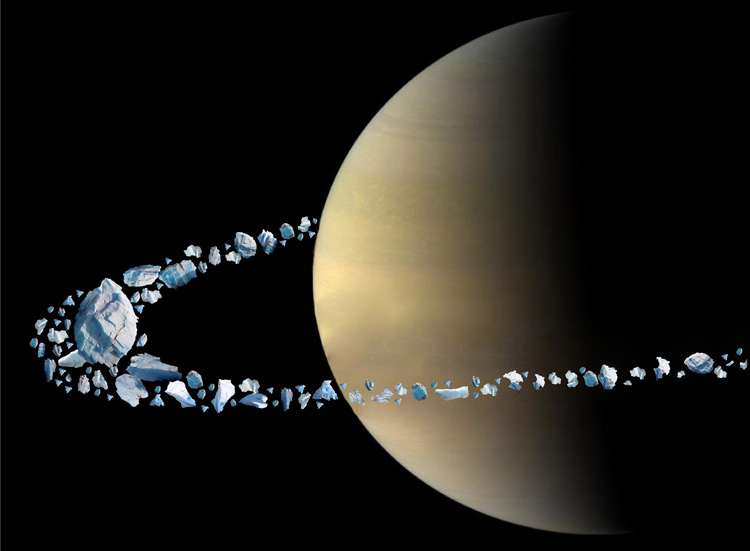
And then there is Titan, not only pulling on Saturn with its own gravity but also migrating away from the ringed planet at a blistering rate of 11 centimeters per year. Compare that with our own Moon moving away at 38 millimeters per year. About 100 to 200 million years ago, Titan ended up in resonance with that possible moon, Chrysalis, and as Titan kept migrating outward, the gravitational pull destabilized Chysalis’s orbit. That destabilization caused Chrysalis to get close enough to Saturn to be torn apart by the gas giant’s gravity, and while almost 99% of the moon ended up plunging into Saturn, the remaining 1% became the dazzling ring system we know today.
Okay, here’s the teal dear: about 100 to 200 million years ago, Titan’s outward migration disturbed the orbit of a moon that then got torn about by Saturn and resulted in the formation of Saturn’s ring system. At the same time, that change in the Saturnian system took the gas giant out of sync with Neptune, causing just enough confusion in some maths to keep scientists looking for answers. And computer simulations came to the rescue.
Or as Wisdom notes: The rapid migration of Titan gives a new possibility for explaining the tilt of Saturn. The formula for the rate of precession of the spin axis depends on the presence of the satellites. So, the system could have escaped the resonance if Saturn used to have an additional satellite that was lost, changing the rate of precession enough to escape the resonance, but leaving the system close to the resonance.
Without a doubt, other research teams will be looking to duplicate this result. That is the beauty of science. If these simulations do hold up, well then, welcome to the solar system Chrysalis, we hardly knew you.
Before we get to this week’s review, Erik has a successful rocket launch to share.
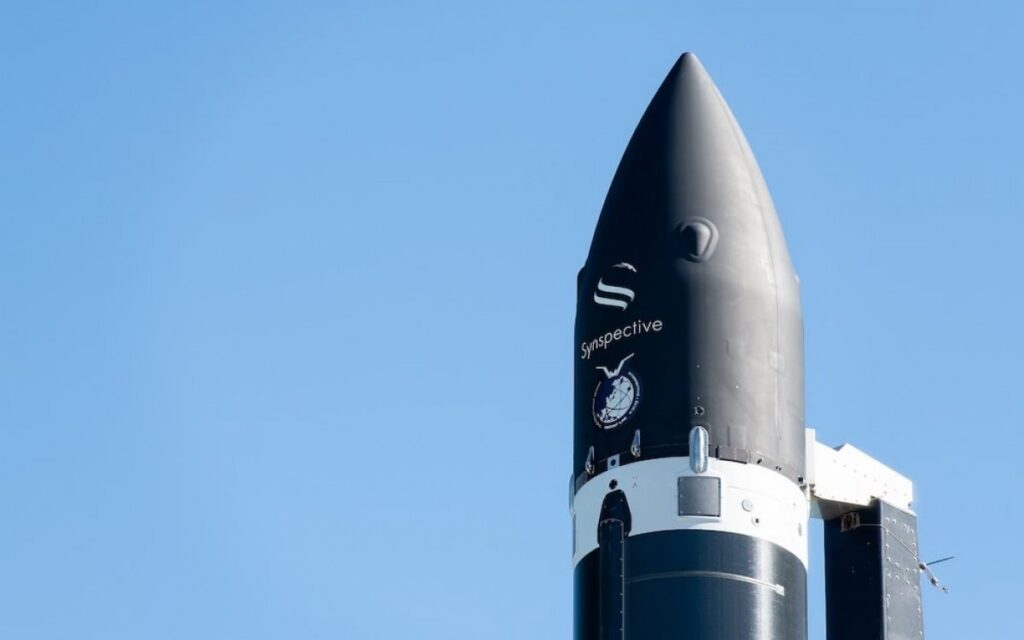
Rocket Lab set a milestone by launching their thirtieth Electron rocket into orbit on September 15. Instead of several small satellites that Electron usually launches, this flight only carried one large 150-kilogram satellite. The payload on last night’s mission was yet another radar satellite for repeat customer Synspective out of Japan. Rocket Lab has now launched three satellites for the company.
The Owl Spreads its Wings launched from LC-1B at Rocket Lab’s launch facility on the Mahia Peninsula in New Zealand and headed south. The first two stages of the Electron rocket delivered the kick stage and payload into an elliptical transfer orbit. From there the kick stage delivered the StriX-1 satellite into its just under 600-kilometer orbit. During the kick stage’s long coast to apogee, the webcast switched to an animation and funky space music, similar to SpaceX.
The launch set a few more milestones for Rocket Lab, featuring the 300th Rutherford engine to fly and 150th satellite Electron has put into orbit.
Rocket Lab has recovered a handful of those Rutherford engines from first stages that have splashed down in the ocean. They recently put one on the test stand after refurbishment and It worked just like an engine straight off the production line, a good sign for their future reuse plans.
From real rockets, we now turn to fictional exploration with a review of Lightyear on Disney+.
Review
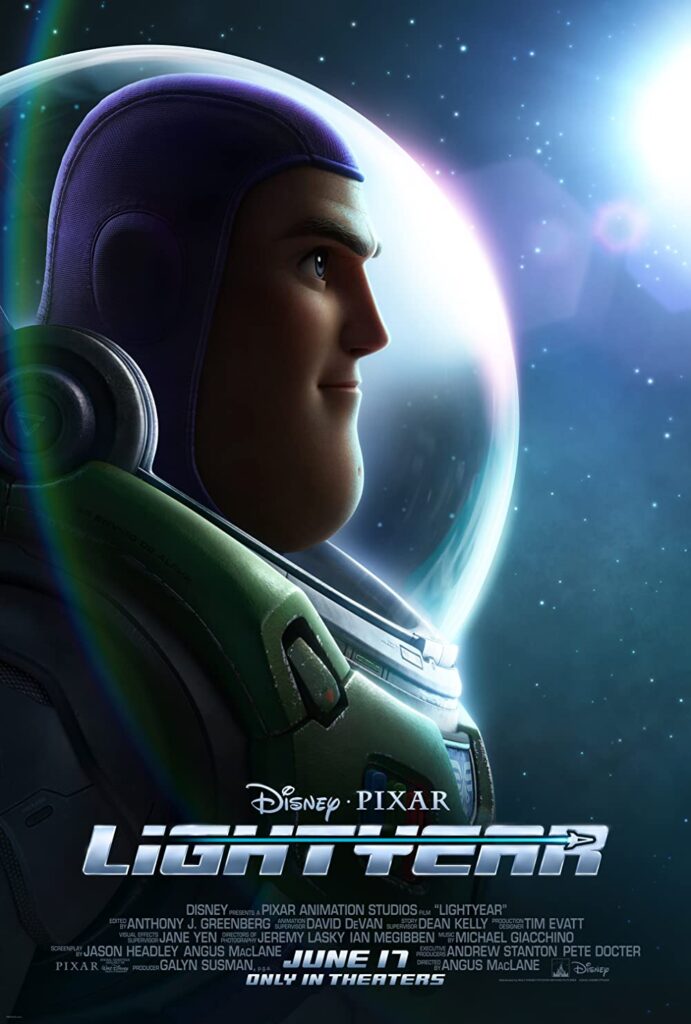
Pamela’s written most of this review, but I’m gonna stay on just a little longer to help her out by giving my own thoughts on the movie. First of all, I want to bring up that Toy Story 2 was one of the first movies I watched in theaters as a kid, so I have good memories of the series.
This movie explains itself as the in-universe inspiration for the toy Buzz Lightyear. Unlike the main Toy Story movies, this Buzz is voiced by Captain America’s Chris Evans.
Lightyear is a space opera like Star Wars, i.e. a movie that uses space as a setting but is not about space. However, it does at least try to have some believable space science as a major plot mechanic, although it is a bit of a MacGuffin to move the plot along. No spoilers as to what science is used, but I think they handled it well.
Overall I liked the movie, particularly the visuals and variety of environments the characters found themselves in. Like a typical Disney movie, there’s something for all ages. I rate it: Childhood Not Ruined.
Now let’s go to Pamela for a more in-depth review.
As you may have noticed, Erik and I aren’t exactly from the same generation. While Toy Story 2 was the first movie he saw in theaters, Toy Story was one of the last Disney movies I saw in a theater while I was in college. The whole concept of “toys actually being alive” is one that has had a soft spot in my heart since I read Hans Christian Anderson’s The Steadfast Tin Soldier when I was little. From reading Lynne Reid Banks’s The Indian in the Attic as a kid to Matt Wallace’s Sundae about a toy bear, this genre is my jam.
And Disney’s new Lightyear has absolutely nothing to do with toys coming to life.
This animated film is meant to be the movie that the Buzz Lightyear toy was associated with. And this difference makes all the difference in… the universe.
This Lightyear looks and sounds as different from thetToy Buzz Lightyear as your typical Luke Skywalker toy is different from Mark Hammil’s live-action portrayal. Note the difference, appreciate the nuance, and move on with your day folks; Disney made a good choice.

And it was just one of many. This is a sweet movie about an exploration vehicle carrying a large and diverse crew setting out to see what new worlds have to offer. During a standard away mission – one that includes landing their entire turnip-shaped ship on a new planet – things go sideways and they have to sort a new way to get home. Like a planet-bound Star Trek: Voyager, we see relationships grow while science works to try and do the probably impossible.
As Erik hinted, the plot is carried by science — good science that doesn’t bog anything down with its details but simply carries the plot forward. Our hero has flaws that are endearing, and the ensemble cast is diverse in a way that feels normal for a future military, and they have quirks that make it all feel human in its animated sweetness. There are also AIs that feel real in their quirks and failings and feel impossibly futuristic in their empathy and some twists that left me saying, “Yes, this is how you get Cylons.” Oh, and there are lots of hidden Star Wars references, so that’s fun too.
This is just a feel-good science fiction movie that in no way made my science-loving brain go boink. If you need a smile and a gentle escape from our world, fall into Lightyear for an evening or afternoon, and enjoy our flawed heroes’ journey
This has been the Daily Space.
You can find more information on all our stories, including images, at DailySpace.org. As always, we’re here thanks to the donations of people like you. If you like our content, please consider joining our Patreon at Patreon.com/CosmoQuestX.
Credits
Written by Pamela Gay, Annie Wilson, Beth Johnson, Erik Madaus, and Gordon Dewis
Hosted by Pamela Gay, Beth Johnson, and Erik Madaus
Audio and Video Editing by Ally Pelphrey
Content Editing by Beth Johnson
Intro and Outro music by Kevin MacLeod, https://incompetech.com/music/


 We record most shows live, on Twitch. Follow us today to get alerts when we go live.
We record most shows live, on Twitch. Follow us today to get alerts when we go live.